
Faxanadu is an action role-playing platform video game developed by Hudson Soft for the Nintendo Entertainment System. The name was licensed by computer game developer Nihon Falcom ("Falcom") and was developed and released in Japan by Hudson Soft for the Famicom in 1987. Nintendo released the game in the United States and Europe as a first-party title under license from Hudson Soft.

Dragon Quest, titled Dragon Warrior when initially localized to North America, is a role-playing video game developed by Chunsoft and published by Enix for the Nintendo Entertainment System. It was originally released in Japan in 1986 and by Nintendo in North America in 1989. It is the first game in the Dragon Quest video game series. Dragon Quest has been ported and remade for several video game platforms, including the MSX, MSX2, PC-9801, Super Famicom, Game Boy Color, mobile phones, and Nintendo Switch as of 2019. The player controls the hero character who is charged with saving the Kingdom of Alefgard and rescuing its princess from the evil Dragonlord. Dragon Warrior's story became the second part in a trilogy, with several spinoff anime and manga series.
1986 saw many sequels and prequels in video games, such as Super Mario Bros. 2, along with new titles such as Arkanoid, Bubble Bobble, Castlevania, Dragon Quest, Ikari Warriors, The Legend of Zelda, Metroid, Out Run and R.B.I. Baseball. The year's highest-grossing arcade video games were Hang-On in Japan, Hang-On and Gauntlet in the United States, and Nemesis (Gradius) in London. The year's best‑selling home system was the Nintendo Entertainment System (Famicom) for the third year in a row, while the year's best-selling home video games in Western markets were Super Mario Bros. in the United States and Yie Ar Kung-Fu in the United Kingdom.

Castlevania III: Dracula's Curse is a 1989 action-platform game developed and published by Konami for the Nintendo Entertainment System. It was released in Japan in 1989, and in North America in 1990, and in Europe by Palcom in 1992. It was later released on the Virtual Console for the Wii, Nintendo 3DS, and Wii U.
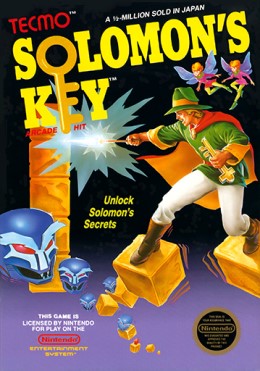
Solomon's Key is a puzzle game developed by Tecmo in 1986 for an arcade release on custom hardware based on the Z80 chipset. It was ported to multiple systems including the Nintendo Entertainment System and Commodore 64. The PC Engine version was known as Zipang and the Game Boy version as Solomon's Club. A prequel, Solomon's Key 2, was released in 1992 for the NES. The game was also ported to Virtual Console for the Nintendo 3DS and Wii U in 2006 and later to Nintendo Switch Online in 2018.

Treasure Hunter G is 1996 a turn-based tactical role-playing game developed by Sting Entertainment and published by Square exclusively for the Super Famicom, and in Japan.

Hudson's Adventure Island, known as Takahashi Meijin no Bōken Jima in Japan and also known as Adventure Island, is a side-scrolling platform game produced by Hudson Soft that was released in Japan for the Famicom and MSX on September 12, 1986. Adventure Island was released in North America for the Nintendo Entertainment System in 1988 and in the PAL region in 1992.

Famicom Wars is a wargame developed by Nintendo and Intelligent Systems and published by Nintendo for the Family Computer. It was released on August 12, 1988, in Japan. It was later re-released on Virtual Console. It is the first game in the Wars series.
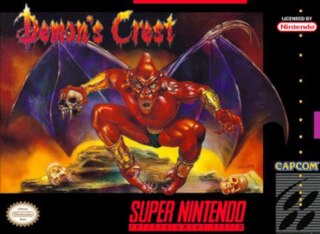
Demon's Crest, known in Japan as Demon's Blazon, is a side-scrolling platform video game developed and published by Capcom for the Super Nintendo Entertainment System. It is the third video game starring Firebrand, following Gargoyle's Quest and Gargoyle's Quest II.
Milon no Hoshizora Shabon: Puzzle Kumikyoku is a Milon's Secret Castle's puzzle game released for the Nintendo DS on July 6, 2006, only in Japan. It was developed by Takumi Corporation and published by Hudson Soft.

Challenger is an action-platform video game developed and published by Hudson Soft for the Famicom in 1985.
Hect (ヘクト) or Hector was a Japanese video game developer and publisher. It had a Virtual Boy game in development, entitled Virtual Battle Ball; however, it was eventually canceled.

Gargoyle's Quest II: The Demon Darkness is a 1992 action-adventure game released on the NES by Capcom. It is the prequel to Gargoyle's Quest and features a similar gameplay style, which combines adventure elements with side-scrolling action in a macabre fantasy setting.

Getsu Fūma Den is an action role-playing video game developed and published by Konami for the Family Computer in 1987 exclusively in Japan. It has been referenced in many subsequent Konami titles throughout the years. The game is structurally similar to Castlevania II: Simon's Quest, The Goonies II and Teenage Mutant Ninja Turtles (NES).
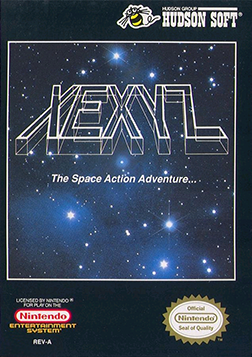
Xexyz, known in Japan as Kame no Ongaeshi - Urashima Densetsu, is a 1988 video game published by Hudson Soft for the Nintendo Entertainment System. The game was released in Japan on August 26, 1988, and saw a North American release sometime in April 1990. The game was never released in Europe and the game is not playable on PAL consoles.

Ys II: Ancient Ys Vanished – The Final Chapter is a 1988 action role-playing game developed by Nihon Falcom. It is a sequel to Ys I: Ancient Ys Vanished and takes place immediately following it. The game first released for the PC-8801 and PC-9801 and has seen several ports and remakes since.
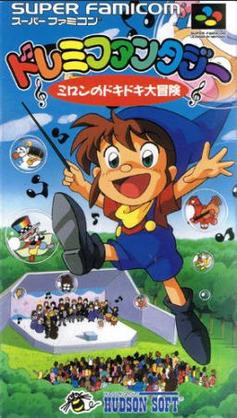
DoReMi Fantasy: Milon's DokiDoki Adventure is a platform game developed and published by Hudson Soft for the Super Famicom. It was released in Japan on March 22, 1996, and later re-released for the Virtual Console in 2008.

Super Contra, known as Super Contra: The Alien Strikes Back in Japan, is a run and gun video game by Konami, originally released as a coin-operated arcade video game in January 1988. It is the sequel to the original Contra and part of the Contra series. The game stars Bill Rizer and Lance Bean as they are sent to thwart another alien invasion from the vicious Red Falcon.

Castlevania, known in Japan as Akumajō Dracula, is a 1986 action-platform game developed and published by Konami for the Family Computer Disk System. It was originally released in Japan in September 1986, before being ported to cartridge format and released in North America for the Nintendo Entertainment System (NES) in May 1987 and in Europe in 1988. It was also re-issued for the Family Computer in cartridge format in 1993. It is the first game in Konami's Castlevania video game series.
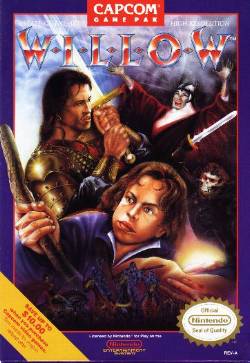
Willow is a 1989 2D action role-playing game developed and published by Capcom for the Nintendo Entertainment System. It is loosely based on the 1988 film of the same name and is the second title Capcom released based on Willow that year, the first being an unrelated side scrolling arcade game. The version of Willow released for the Nintendo Entertainment System and the Famicom is an adventure game in the vein of The Legend of Zelda.


















